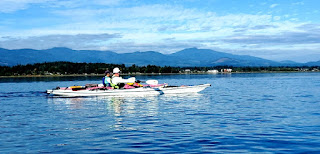The weather favoured our flotilla of small watercraft once again. Calm conditions prevailed under sunny skies and mid-20s warmth. There were 22 paddlers, 14 single and two tandem kayaks, and two tandem canoes. We assembled on the gravel beach on the Royston waterfront to offload boats from our vehicles. The tide was moving out rapidly requiring us to reposition closer to the water's edge before launching.
The low tide level allowed us to explore the rusting hulls of a few ships sunken to form a breakwater to protect the log boom area of Comox Harbour from the sometimes stormy sea roiling into the bay.
The breakwater holds the skeletons of 14 ships, the first of which was set in place in 1936 by Comox Logging and Railway Company. The first ship to be scuttled was named the Laurel Whalen, built in 1917. The last ship was positioned in 1959: a wood tug named ATR-13. Among the hulls that can still be seen are two 19th century ships: the Riversdale and the Melanope, both three-masted windjammers. The website https://www.atlasobscura.com/places/royston-shipwrecks informs us that the Riversdale was "a fine example of late 19th century English ship building". It was built in and launched from Liverpool in 1894. The Melanope was a generation older than the Riversdale, and was also from Liverpool. It was launched in 1876 and served "as everything from an immigrant ship to a railway coal barge, hauling cargo to Australia and rice from Asia in between".
We paddled from the shipwrecks across the shallow waters of the Puntledge River estuary then pushed a short distance upstream against the current. The estuary is a haven for salmon fry and small fish that thrive in waving eel grass that provides food and shelter for them. Only one large chinook salmon was seen. A paddler who had been fishing upstream two days previously commented the river was full of pink and chinook salmon heading upstream in their final push to spawn. At least a dozen seals were counted in the river mouth - looking hungry for salmon.
Our flotilla paddled along the far shore and entered the protected back channel of the Comox Marina.
The water level was low, but was sufficient to allow us to paddle past a charter boat house, skiffs of all sorts, and a couple of dragon boats. We hauled out at the boat launch and lined up our kayaks and canoes along a wall of the ramp, well out of the way of people launching power boats.
The view from the Harbour walkway was spectacular.
After a short break we completed a paddling tour around the marina
then headed to the sandy beach of Goose Spit for lunch.
Goose Spit's Indigenous name is Pelxqikw, which means “round on point.” Both sides of the spit were used by local First Nations to collect clams and cockles in spring and to fish for salmon in winter. A totem pole erected in 2018 near the head of Goose Spit marks Komoks First Nation traditional land.
While sitting on the sloping sandy beach during lunch break we took in breath taking views from the head of the Spit: sail boats in the foreground, blue sky water of the harbour, mountains and the Comox Glacier forming a picture perfect backdrop.
A perfect paddling day ended with a stop for ice cream at the Cone Zone in Qualicum Bay.
Trip Report by Cormack
Photo contributions by Bruce, Penny, Elizabeth, Pat, Lil, Scott, Gilles, Linda, Cormack and Jim




























No comments:
Post a Comment
Note: Only a member of this blog may post a comment.